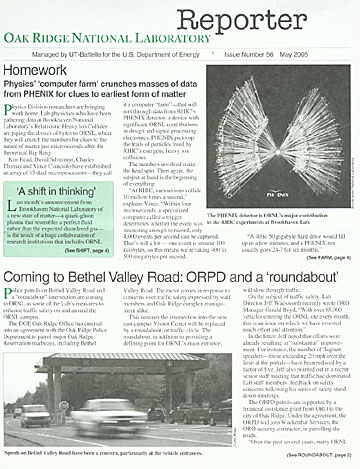| Number 66, May 2005 |
 |
 Homework
Homework
Physics’ ‘computer farm’ crunches masses of data from PHENIX for clues to earliest form of matter
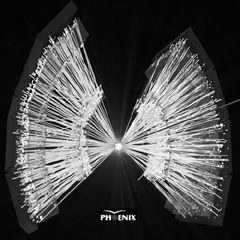 |
| The PHENIX detector is ORNL’s major contribution to the RHIC experiments at Brookhaven Lab. |
Physics Division researchers are bringing work home. Lab physicists who have been gathering data at Brookhaven National Laboratory’s Relativistic Heavy Ion Collider are piping the droves of bytes to ORNL, where they will crunch the numbers for clues to the nature of matter just microseconds after the theoretical Big Bang.
Ken Read, David Silvermyr, Charles Thomas and Vince Cianciolo have established an array of 15 dual microprocessors— they call it a computer “farm”—that will sort through data from RHIC’s PHENIX detector, a device with significant ORNL contributions in design and signal processing electronics. PHENIX picks up the trails of particles freed by RHIC’s energetic heavy ion collisions.
The numbers involved make the head spin. Then again, the subject at hand is the beginning of everything.
“At RHIC, various ions collide 10 million times a second,” explains Vince. “Within four microseconds, a specialized computer called a trigger determines whether the event was interesting enough to record; only 4,000 events per second can be captured. That’s still a lot — one event is around 100 kilobytes, so this means we’re taking 400 to 500 megabytes per second.
“A 40 to 50 gigabyte hard drive would fill up in a few minutes, and a PHENIX run usually goes 24-7 for six months.”
Although initially all data was to be analyzed at Brookhaven, the massive amounts of it have necessitated a farming out, so to speak, of the work.
To handle the staggering load of information, the PHENIX team filters the data, looking for evidence of events— represented as streaks across a visualized detector image—that shed light on the quark-gluon plasma, a theoretical soup of quarks and gluons that existed briefly after the Big Bang.
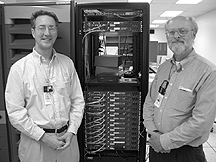 |
| There you have it: Ken Read (top right) and Charles Thomas with their computer farm. Below are Vince Cianciolo, David Silvermyr and Glenn Young. |
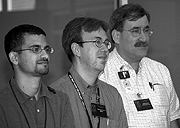
|
Of particular interest are events that contain a particle called the J/R, a meson made of one quark and one antiquark that decays into two particles called muons, one positively and one negatively charged. The J/R is a tool for physicists, serving as a “witness” particle to the Big Bang aftermath they are recreating in the lab.
Physics Division Director Glenn Young was one of the early advocates for building a detector capable of measuring the J/R in RHIC collisions and one of the founding members of the PHENIX experiment. Vince also credits Glenn with convincing the project to preserve RHIC’s ability to collide large and small nuclei, a versatility that has produced interesting results and, in the case of colliding gold nuclei and a deuteron, has been important as a control experiment.
“Each time these beams collide, it’s a picture, an independent event. These filters reduce the data set by hundreds, which we can more easily handle and store on our disks at ORNL, analyzing the data as we collect it,” says Vince. “Our ability to analyze the data off-site within a month is unprecedented.”
It’s all done with fast network infrastructure spilling out of Brookhaven, located on New York’s Long Island, at 400 megabits per second. The state-of-the-art office system speed is 1,000 megabits per second.
“So we’re communicating with New York at 40 percent of that, while competing with the rest of the country,” Ken Read notes.
Interpreting the data is a “giant connect-the-dots problem that is solved with an algorithm,” says Ken.
“We superimpose several of these puzzles and remove the numbers, so to speak. The path and arc left by the particle lets you determine its mass, how much energy it had and what kind of particle it was,” Ken says.
The PHENIX team says the computer farm’s breakthrough is with digital technologies and computational pattern recognition models—computers plus physics insight that help the researchers develop the algorithms that interpret the data.
The computers themselves are unassuming in appearance or, perhaps, dynamite in a small package. Thirty 3.0 gigahertz CPUs and 12 terabytes of disk space (a terabyte equals 1,000 gigabytes) are stored in a single metal cabinet occupying a small corner in the Holifield Radioactive Ion Beam Facility, where Charles Thomas watches over the setup.
“The massive amount of disk space is really critical to the projects we want to carry out,” Ken says. Also, notes Cianciolo, “The fact that each event is independent means that sophisticated supercomputer architecture is unnecessary. You do just as well by running many desktop computers in parallel.”
By measuring the momentum and angle as picked up by PHENIX, they can determine if the muons came from a J/y.
Ken explains that understanding the RHIC events provides an understanding of the laws of physics that operated at the beginning of the universe.
“RHIC is trying to re-create matter at extremes of temperature and density not seen since those microseconds after the Big Bang. The goal is to understand the laws of physics at those extremes and test specific theories of the strong nuclear force,” Ken says.
“It’s analogous to looking farther back in time,” he says.
David Silvermyr, a Wigner Fellow working in the Physics Division, explains that the theory of quantum chromodynamics (QCD), which was the subject of the most recent Nobel Prize for Physics, holds that in those early moments, quarks and gluons melted into a quark-gluon plasma “soup” before settling out to form the protons, neutrons, atoms and elements that make up the universe.
There’s something there. It’s dense, it’s sticky, it’s strongly interacting. It’s not precisely what we set out to find 10 years ago. |
|---|
“It looks like that quark-gluon soup may be created in these collisions. It is very liquid-like, and may be the most perfect liquid known in terms of how well it conforms to the laws of hydrodynamics,” David says.
“We’re testing an as-yet unconfirmed prediction of QCD. Early indications are that there is a quark-gluon plasma state of matter. Predictions have been close, but there are differences,” he says.
Ken adds that reconstructing J/ys offers clues into the nature and properties of the quark-gluon plasma. Through a process of falsifying hypotheses—basically testing them until they break—the researchers are arriving at some understanding of the nature of this perfect-liquid soup.
“There’s something there. It’s dense, it’s sticky, it’s strongly interacting. It’s not precisely what we set out to find 10 years ago. Mother Nature is throwing us some more monkey wrenches, which means it is becoming even more exciting,” Ken says. “But we are making measurements, winnowing out the wrong predictions and we are hemming it in.”
And thanks to high-speed data links and advances in scientific computing, the
PHENIX team is doing the work “at home” at ORNL.—Bill Cabage
 Coming to Bethel Valley Road: ORPD and a ‘roundabout’
Coming to Bethel Valley Road: ORPD and a ‘roundabout’
 |
| Speeds on Bethel Valley Road have been a concern, particularly at the vehicle entrances. |
Police patrols on Bethel Valley Road and
a “roundabout” intersection are coming to ORNL as some of the Lab’s measures to enhance traffic safety on and around the ORNL campus.
The DOE Oak Ridge Office has entered into an agreement with the Oak Ridge Police Department to patrol major Oak Ridge Reservation roadways, including Bethel Valley Road. The move comes in response to concerns over traffic safety expressed by staff members and Oak Ridge complex management alike.
This summer the intersection into the new east campus Visitor Center will be replaced by a roundabout, or traffic circle. The roundabout, in addition to providing a defining point for ORNL’s main entrance, will slow through traffic.
On the subject of traffic safety, Lab Director Jeff Wadsworth recently wrote ORO Manager Gerald Boyd, “With over 85,000 vehicles entering the ORNL site every month, this is an issue on which we have invested much effort and attention.”
In the letter, Jeff noted that efforts were already resulting in “substantial” improvement. For instance, the number of flagrant speeders—those exceeding 20 mph over the limit at the portals—have been reduced by a factor of five. Jeff also pointed out in a recent senior staff meeting that traffic had dominated Lab staff members’ feedback on safety concerns following his series of safety stand-down meetings.
The ORPD patrols are supported by a financial assistance grant from ORO to the city of Oak Ridge. Under the agreement, the ORPD will join Wackenhut Services, the ORO security contractor, in patrolling the roads.
“Over the past several years, many ORNL employees have raised concerns that traffic safety was an element of the Integrated Safety Management System that was not receiving its proper emphasis,” says Laboratory Protection Division Director Paul Gubanc. “UT-Battelle heard these requests and has implemented many enhancements, both technological and administrative, to improve traffic safety within ORNL, and especially on Bethel Valley Road.”
Paul adds: “Regardless of the measures we put in to ensure safety, it is ultimately up to the driver to operate the vehicle in a safe manner. We won’t have safe roadways if the drivers don’t take their responsibility seriously.”
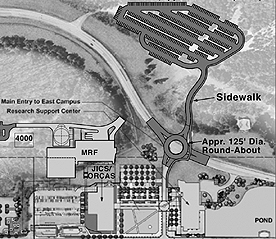 |
| This artist’s concept of the east campus includes the Multiprogram Research Facility, the planned roundabout and a new 400-space parking lot. |
Safety measures include the roundabout, a traffic calming device that forces vehicles to slow down to negotiate the circle’s curve. A crosswalk from a new 400-space parking lot soon to be constructed on the north side of Bethel Valley Road will also be part of the roundabout design.
The Facilities Development Division’s Lanny Bates says the construction for the roundabout will cause some traffic congestion and rerouting during the 10 to 12 weeks expected to complete the project. The route into the Visitor Center for ORNL guests and visitors will be most significantly affected, perhaps requiring access from Central Avenue for a brief period.
Other physical safety measures include radar speed indicator signs at the vehicle entrances, traffic signs, clearly marked merge lanes, speed humps and rumble strips at selected locations—for instance, where pedestrian traffic is heavy.
Enforcement measures include surveillance (for example, speed is monitored for all cars exiting through the portals), weekly violator reports to managers and investigations of unsafe driving reports.
Disciplinary measures include a warning for first offenses and measures that increase in severity for repeat violations. Fortunately there have been few repeat offenders. In fact, Jeff’s letter noted that the majority of speeders on Bethel Valley Road were not ORNL employees. Those violators are referred to their employers.
Expectations of safe driving underpin all these measures, and ORNL policies are communicated through General Employee Training, the Director’s Message e-mails, staff meetings, the Safety First Program, ORNL Today and, of course, in ORNL
Reporter. — B.C.
 Multiprogram facility caps east construction
Multiprogram facility caps east construction
The last big construction project for ORNL ‘s east campus is under way. Site preparation for a new privately funded office building—the Multiprogram Research Facility—has resulted in the clearing and leveling of the hillside across Central Avenue from the 4500 complex.
Construction in the area also is going to provide around 600 badly needed parking spaces to the east campus.
The MRF is a $41 million, 250,000-square- foot facility comprising a pair of four-floor wings of offices and labs. Reflecting its name, tenants will include researchers from a variety of Lab divisions and staff from the National Security Directorate, who are currently stationed in various offices across the Lab.
With the facility slated for completion a year from now (May 2006), Deputy Director for Operations Jeff Smith says the new space will enable the Lab to continue the effort started in 2003 to consolidate staff into fewer, more modern facilities.
Also in the works is relief from the packed parking conditions on the east end: a 400-space lot located across Bethel Valley Road near the site of the old visitor overlook. That lot is slated to be finished this fall. Around 200 more spaces will be added west of the MRF in early 2006.
Heery International, the firm that managed construction of the privately funded Research Office Building complex, is also managing construction of the MRF. The facility will incorporate “green” standards and be LEEDS Silver certified. The project will benefit from lessons learned in the Research Office Building complex construction.
One emerging ORNL technology is being designed into the facility: The MRF will have fittings and dish supports to accommodate hybrid lighting, a fiber-optic-based internal lighting system being developed by the Engineering S&T Division.—B.C.
 Those ‘first years’ are the toughest
Those ‘first years’ are the toughest

This year’s State of the Laboratory talk on April 21 was double the fun: It was preceded by a party for Alvin Weinberg, who turned 90 the day before.
“The first 90 years are the toughest,” ORNL’s director emeritus opined.
Lab Director Jeff Wadsworth might have said the first five years are the toughest for running a national laboratory; instead, he took the Friends of ORNL Community Lecture audience through some of UT-Battelle’s achievements in its five years, most notably to keeping the Spallation Neutron Source on time, on budget and on scope; landing the National Leadership Computing Facility; and converting the old east parking lot into a complex of imposing, state-of-the-art new facilities.
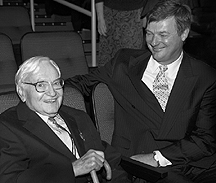 |
|---|
New nonagenarian Alvin Weinberg stayed for ORNL Director Jeff Wadsworth’s State of the Laboratory talk. |
Jeff noted that UT-Battelle took some careful risks that have paid off. For instance, the computing space provided in the privately funded facilities was a factor in winning the NLCF.
“We take risks,” he said. “You don’t get progress unless you take risks.”
At the birthday party, Jeff credited Dr. Weinberg’s role in a number of scientific fronts: nuclear medicine, nuclear power generation and studies of atmospheric carbon dioxide, to name a few.
 Graphite foam reaches new heights
Graphite foam reaches new heights
NASA launched a satellite, called XSS-11, in April. One of the spacecraft’s goals is to test technologies needed for missions to Mars that will collect rock and soil samples and return them to Earth. The launch was of interest to the Metals & Ceramics Division’s James Klett because it has a radiator made of graphite foam, which was developed by an M&C Division team led by James.
“The most interesting thing is that one of my first publications on the foam suggested this very application,” James says.
Sure enough, he cited graphite foam’s excellent thermal transfer properties and light weight when pitching the new material in the late ’90s. Another version of the tiny, 100-kg satellite with an identical radiator made of PocoFoam, its trademarked name, is planned for launch later this year.
Other suggested applications have in- cluded use in race cars and microcomputers.
“It is not every day that new materials we develop at ORNL make it to functioning space hardware—not an experiment but a functioning piece of equipment meant for a specific task—only eight years after initial discovery,” James says. “Way cool.”
 Partners part on Chestnut Ridge
Partners part on Chestnut Ridge
Speaking of the SNS, Jefferson Lab has delivered a cryogenic plant and all 23 cryomodules it was contracted to fabricate, assemble and test for the project. The cyromodules are the major component in the SNS’s superconducting linear accelerator.
The modules will accelerate protons into the mercury target to produce a beam of neutrons 10 times brighter than any other existing source.
On April 21, Thom Mason, Norbert Holtkamp and Carl Strawbridge of SNS attended Brookhaven Lab’s hand-off ceremony marking the delivery of the accumulator-storage ring and associated beam transport lines.
These events mean that ORNL’s five partner labs in the project—Argonne, Los Alamos, Berkeley, Brookhaven and Jefferson—have completed their portions of the project and the SNS is now ORNL’s baby.
Jeff Wadsworth noted in the State of the Laboratory talk that in 2000 no one was sure the six-lab partnership would work.
At the Brookhaven ceremony on the same day, Norbert, who directs the Accelerator Systems Division, observed that the end of the six-lab partnership marked a great achievement.
“We have shown that interlab collaborations can be successfully completed,” he says, adding a bit warily, “We are now on our own. We can blame only ourselves for any mistakes.”
 Tales from the vault
Tales from the vault
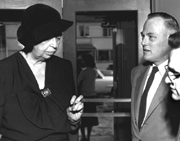 |
|---|
ORINS Director William G. Pollard with Eleanor Roosevelt in 1955. |
ORNL’s Communications shop receives its share of unusual requests. A recent e-mail from a University of Florida graduate student is a case in point.
A time capsule was placed in the university’s College of Medicine building’s cornerstone in 1955, to be opened during its 50th year. A scan of documents revealed that the trove contains “a radioactive item … from Oak Ridge.”
The graduate student (museum studies) wanted to make sure the parcel wouldn’t harm any spectators at the opening. Florida radiation safety officers opened the time capsule and found a welded aluminum cylinder with only background radiation levels. They cut open the cylinder to find a smaller welded capsule labeled “Carbon 14 capsule for cornerstone ceremony from Oak Ridge Institute of Nuclear Studies.”
The smaller capsule will be left intact and will likely go into a display case.
The grad student’s further research turned up a 1955 letter from then-Florida Provost Russell S. Poor, who came to Florida from Oak Ridge, to William G. Pollard, who was director of ORINS at the time, thanking him for the sample.
Poor wrote, “As you would expect, the press picked up this feature and, as a result, our stories received much wider coverage than might have otherwise been the case. It didn’t matter whether anyone knew what the nature of the radioactive material was or for what real scientific purposes it might ever be useful because the magic of Oak Ridge still surrounds anything which originates from that point.”
Fifty years later, it still does.
—Reported by Bill Cabage |
 Poster session displays depth & breadth of women in science at ORNL
Poster session displays depth & breadth of women in science at ORNL
 |
|---|
The Environmental Sciences Division’s Madhavi Martin explains her poster to Biological and Environmental Sciences Associate Laboratory Director Reinhold Mann. |
Thirty-three researchers and an elbow-to-
elbow crowd showed up on March 29 to “celebrate women in science” in a Research Support Center poster session sponsored by the ORNL Committee for Women and the Women’s History Month Committee. The session featured research by women ranging from some of the Lab’s most seasoned scientists to postdocs just arrived on the scene.
Lynn Kszos, who took the lead in organizing the Women’s History Month event, was pleased with both the turnout of the presenters and onlookers. “This has been an impressive show of Lab research by women and of the Laboratory staff’s interest in their work,” she said.
Topics spanned subjects as established as mammalian genetics research to emerging areas such as crystallography in the Spallation Neutron Source. The work represented a dozen ORNL divisions.
The show was dedicated to the memory of Dorothy Skinner, who died in February. The former Biology Division researcher was remembered as a champion of the equal treatment of women in science.
 ORNL flies ISO 14001 banner
ORNL flies ISO 14001 banner
 |
|---|
| (From left) Jeff Smith, Kathy Carney, Oak Ridge Mayor David Bradshaw, David Skipper and Karen Downer pose with the ISO 14001 banner on Main Street.
|
Deputy Director for Operations Jeff Smith
and ESH&Q Director Karen Downer recently welcomed Oak Ridge Mayor David Bradshaw and a group from the Tennessee Department of Environment and Conservation, including its director of Oak Ridge oversight, John Owsley, for a ceremonial dedication of an ISO 14001 banner.
ORNL’s ISO 14001 registration means that the Laboratory’s Environmental Management System conforms to an internationally recognized standard of excellence and is a leader in its field. Attaining the standard took years of hard work by hundreds of ORNL staff members.
Mayor Bradshaw voiced the city of Oak Ridge’s appreciation of the Lab’s dedication to excellence in environmental management.
“The community notices these things,” he said. “They note that when you meet these kind of criteria, you are doing the right thing for the environment. We want you to participate in our community in a safe work environment.”.
 Horton, Lowndes to lead Center
for Nanophase Materials Sciences
Horton, Lowndes to lead Center
for Nanophase Materials Sciences

|
 |
|---|---|
|
|
Lowndes |
Linda Horton and Doug Lowndes have
been named director and scientific director respectively of the Center for Nanophase Materials Sciences, the nanoscale research facility that is in its final stages of construction on Chestnut Ridge.
The new nanoscience center is one of five planned by DOE’s Office of Science and the first to be funded and completed. Both Linda and Doug have worked closely with the project throughout its proposal and construction stages.
The CNMS sits adjacent to the Spallation Neutron Source. Experiments from the CNMS will be ready for neutron analysis when the SNS, which will be the world’s leading neutron science facility, comes on line in 2006.
“As we prepare for the transition from construction to full operations it is critically important to appoint the strongest leadership team, and we have that in Linda and Doug,” says ORNL Director Jeff Wadsworth.
Linda is currently manager of ORNL’s Basic Energy Sciences Materials and Engineering Physics program and has served as the CNMS’s project director during construction. She will oversee all aspects of the center and work with Lowndes to ensure the overall success of the center.
“Linda has led various reviews and coordinated all operational aspects of the CNMS. As a result, she has earned the highest respect of program managers and the CNMS staff, making her exceptionally well-qualified for this position,” said Associate Laboratory Director for Physical Sciences Michelle Buchanan.
Doug, a UT-Battelle corporate fellow and senior researcher in the Condensed Matter Sciences Division, led the proposal to bring the CNMS to Oak Ridge and has overseen the center’s user program, which already has 64 projects in progress.
“Doug, who has been key to the development of the CNMS since its conception, will focus on the continued growth of a strong scientific program as scientific director,” Michelle says.
 New Staff Members
New Staff Members
ORNL continues to grow. Welcome to the following new Laboratory employees.
Janie Arline Blackwell, Linda Lou Duncan and Maggie Jeanette Miller, Networking & Computing Technologies
Michael Boyd Edgemon, Brian Joseph Goad, Stewart Jeffrey Shipwash, Gerald Wayne Burchfield Jr., Michael Gregg Sexton, Richard Irwin Lovelace, Joseph Charles Bravelion, Jackie David Watkins Jr., and Ronnie Scott Maples, Craft Resources
Justin Brant Ferrell, Samuel Clarence Howard, Stephanie Arlene Cale and Julie Anne Holthausen, Business & Information Services
Pratul Kumar Agarwal, Linda Hubbard Gregg, Jamison Robert Daniel, Christopher Brian Fuson, William Anthony Renaud, Robert Moreland Whitten Jr. and Honghoe Ong, Computer Science & Mathematics
Barbara G. Beckerman and Michael Stephen Neergaard, Computational Science & Engineering
Joseph Haley Anderson, Hassina Zaim Bilheux, Benjamin J. Cagley, Ellen Waynette Dawkins, Bruce Hill, Theodore Visscher, Russell D. Henderson, Sarah H. Parker, Cecil Craig Smith, William Boyd Reynolds, Gerald E. Ferguson and Michael Anthony Reuter, Spallation Neutron Source
Kevin David Freudenberg, Fusion Energy
Emily Christine Bartlett, Human Resources
John Paul Shingledecker and Roger Gene Miller, Metals & Ceramics
James David McNeal, Laboratory
Protection
Kathy Louise Phillips and Niels de Jonge, Condensed Matter Sciences
Kenneth Watson Brown, Facilities Development
Steven David Brown and Brennan Thomas Smith, Environmental Sciences
Brad James Stinson, Engineering Science & Technology
Thomas Lawler Wilson Jr., Nuclear Science & Technology
Jonathan Richard Mielenz, Life Sciences
Markus Arthur Camfield, Colinda Beeler Moody and Dalena Carol Lohman, Contracts
Charles Patrick Richardson, Technology Transfer & Economic Development
 ORNL People
ORNL People
ORNL Corporate Fellow Stan David, Metals & Ceramics Division, recently delivered an invited lecture—the G.E. Distinguished Lecture in Materials Science and Engineering—at the Rensselaer Polytechnic Institute in Troy, N.Y. Stan’s talk was titled, “Science Base for the Joining Technologies of the Future.”

|
|---|
|
Forsberg |
The Nuclear S&T Division’s Charles Forsberg has been selected to receive the Robert E. Wilson award by the American Institute of Chemical Engineers. Past award recipients include the late Floyd Culler, past ORNL researcher and manager. The award recognizes outstanding chemical engineering contributions to the nuclear industry.
The Engineering S&T Division’s Pat Hu has been appointed to the National Research Council’s Committee on Planning for Catastrophe: A Blueprint for Improving Geospatial Data, Tools and Infrastructure. The committee will assess the status of and needed improvements in core geospatial data, analytical tools and infrastructure for enhancing decision making in emergency situations.
The Physics Division’s David Schultz was recently elected secretary-treasurer of the American Physical Society’s Division of Atomic, Molecular, and Optical Physics for a three-year term. Dave has also been named local co-chair of next year’s DAMOP annual meeting, which will be held at the Knoxville Convention Center.
The Condensed Matter Sciences Division’s Lynn Boatner has been re-elected to the American Association for Crystal Growth’s executive committee. His new six-year term starts in July. Lynn is founder and curator of the American Conference on Crystal Growth Collection, currently on display at McGhee Tyson Airport in Knoxville.
The M&C Division’s Ron Klueh has been selected to receive the Special Achievement Award by the American Nuclear Society for his co-authored book, High-Chromium Ferritic and Martensitic Steels for Nuclear Applications.
M&C’s Tom Rosseel has been elected as an alderman for the town of Farragut, representing citizens on the north end. ORNL retiree Eddy Ford was elected to his fourth term as mayor of Farragut.
A book co-edited by M&C’s Amit Goyal, titled Synthesis, Properties, and Crystal Chemistry of Perovskite-Based Materials, has been published by the American Ceramic Society. Co-editors for the book are Winnie Wong-Ng, Ruyan Guo and Amar Bhalla.
A research paper co-authored by Chinn-Chi (Jim) Tsai of the Fusion Energy Division has won the Outstanding Paper Award from the Atomic Energy Society of Japan.
 Spring Team UT-Battelle projects bloom
Spring Team UT-Battelle projects bloom
The usual spring surge in community fundraising activities arrived on schedule this year. Below is a list of numerous events supported by Team UT-Battelle, which helps employees who have adopted community causes with organizing support efforts.
The Melton Hill Lake Trash Bash team, captained by Daron Long, picked up trash on the banks of the nearby lake on April 2.
Tim Jones captained a team to conduct the Pellissippi District Cub Scouts’ Pinewood Derby on April 9.
Volunteers gathered at the Chimneys picnic area for this year’s Help the Smokies effort on April 16. Captain Kim McMahan says more weekend work days to refurbish the national park’s day-use area will be scheduled.
Two “walks” occurred on April 23—the Anderson County Kidney Walk, captained by Beverly Abele, and the Walk for Multiple Sclerosis, captained by Sharon Thompson. The teams sported Team UT-Battelle t-shirts.
Fred Strohl is captain of the Team UT-Battelle group supporting this year’s March of Dimes walk on May 7.
The Highway 95 Trash Bash is set for May 11, weather permitting, to remove litter from the section of the road that runs through the ORR. Meredith Leahy is captain.
Kahra Gilley is leading a team supporting The Juvenile Diabetes Research Foundation Walk on May 14. The same weekend, Bruce Siefken is leading a cycling team on the two-day Tour de Cure for the American Diabetes Association.
Team UT-Battelle is supporting two Relay For Life weekends for the American Cancer Society. Karen Murphy is captain of the ORNL team for the Oak Ridge RFL May 20-21; Susie Kuliasha is leading the Lab effort for the Anderson County RFL on June 4.
If you have a community-related cause that Team UT-Battelle might support, contact Community Outreach’s Brenda Hackworth, hackworthbt@ornl.gov, or Bill Pardue, pardueb@ornl.gov.
 Letters
Letters
Setting the R&D record straight
The awardees of the 2004 R&D 100 Award “Highly Selective, Regenerable Perchlorate Treatment System” are correctly given as Baohua Gu (ORNL, Environmental Sciences Division), Gilbert M. Brown, Bruce A. Moyer, Peter V. Bonnesen (ORNL Chemical Sciences Division), Spiro D. Alexandratos (University of Tennessee, now at CUNY Hunter College), and Paul Schiff (Edwards Air Force Base). We greatly regret the omission of Prof. Alexandratos from the award as initially presented. Prof. Alexandratos synthesized the first BiQuat materials for this technology, combining high selectivity for charge-diffuse anions like perchlorate with rapid kinetics by mixing short-chain and long-chain quaternary ammonium groups on the same polystyrene-DVB resin beads.
B. Gu, Environmental Sciences Division; G.M. Brown, B.A. Moyer and P.V. Bonnesen, Chemical Sciences Division
Reporting fraud, waste, abuse
UT-Battelle is committed to performing its business activities with the highest standards of integrity, honesty and professional competency. As a UT-Battelle employee, you play an important role in our commitment to maintaining the highest business standards through your individual commitment to excellence.
Further, you have the responsibility to provide notice of inappropriate activities which threaten our joint dedication to integrity in the workplace and which may prevent us from meeting the expectations of DOE and our other customers.
For work done under the DOE contract, UT-Battelle employees have a number of options for expressing their concerns about activities they may view as inappropriate on the job. Any employee with information about alleged fraud, waste, abuse, corruption or mismanagement relating to DOE programs, operations, funds or contracts may provide information directly to the following.
- Line management
- Scott Branham, director of the Audit and Assessment Directorate (241-7614 or home.ornl.gov/directorates/audit_assessment/index.shtml)
- Cindy Kendrick, Employee Concerns coordinator (241-6584 or home.ornl.gov/programs/employee_concerns)
- The Office of Inspector General (IG), 1-800-541-1625. The toll-free hotline number is operated 24 hours a day to permit immediate access by any employee.
All such disclosures may be made without fear of employer reprisal. Employees are also free to refuse to engage in illegal or dangerous activities which the employee believes to be unsafe; to violate laws, rules or regulations; or to involve fraud, mismanagement, waste or abuse.
Also, it is important that all employees work cooperatively with internal and external auditors and investigators.
Scott Branham, Director
Audit and Assessment Directorate
 Multicultural club open to all
Multicultural club open to all
ORNL has formed a Multicultural Friendship Club, dedicated to promoting a better understanding and appreciation of the many nationalities and cultures that co-exist within the ORNL community and to building multicultural friendships. All employees are welcome to participate. Monthly activities are being planned, including tours and gatherings.
For further information about the Team UT-Battelle Multicultural Friendship Club, contact Nancy Gray, e-mail graynl@ornl.gov, or call 576-9479.
 PAC05 hosts scientists all week long, public one fun night
PAC05 hosts scientists all week long, public one fun night
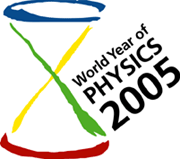 |
|---|
Particle physicists from all over the world are coming to Knoxville this month for the 2005 Particle Accelerator Conference, May 16–20, at the Knoxville Convention Center. The public is invited, as part of the conference, to a World Year of Physics festival on May 18 on the World’s Fair site.
ORNL’s Spallation Neutron Source and Thomas Jefferson National Accelerator Facility are hosting the conference, the 21st in this series.
“This conference and its more than 1,200 attendees will cover new developments in all aspects of the science, technology and use of particle accelerators,” says Norbert Holtkamp of the SNS’s Accelerator Systems Division and conference chair. “We also hope to attract as many attendees as we can to a tour of the SNS on the Saturday following the conference.” (In fact, 200 registrants also signed up for the day-after tour.)
Although the SNS has expanded interest in particle accelerator physics at ORNL, the Lab goes a long way back with the biannual conference. Robert S. Livingston, who led the construction of ORNL’s first 22-inch cyclotron in the late 1940s, hosted the first two Particle Accelerator Conferences in 1965 and 1967 in Washington, D.C.
Topics at this year’s PAC05 conference revolve around the World Year of Physics, which marks the 100th anniversary of Albert Einstein’s “miraculous year” in 1905, when he published three papers that revolutionized the physical sciences.
Tennessee Gov. Phil Bredesen, a physics graduate of Harvard University, will welcome the conference attendees on May 16. Cecilia Jarlskog of Lund University, a member of the Nobel Prize committee, will describe in the opening remarks how Einstein won the Nobel Prize for Physics in 1921.
Nobel laureate Carlo Rubbia is on the agenda for Wednesday, May 18, as part of a public World Year of Physics event featuring popular scientific discussions, science projects by area students, activities, food and entertainment.
PAC05, which this year will have a large representation of researchers from Europe and Asia, represents the world community of particle accelerator scientists who assemble for the conference every two years.
“This is the first time we have had a large participation from India and China, in particular,” Norbert says.
Scientific presentations and seminars include plans for and status of existing and next-generation particle accelerator facilities. Among them are synchrotron light sources, which represent the majority of currently existing research accelerators.
Conference topics will also include the planned scientific applications of the Spallation Neutron Source and other high energy and nuclear physics facilities. Participants will also feature the latest in superconducting linear accelerator technologies and the latest achievements in the realm of particle accelerator physics. — B.C.
 Secret City Festival
concert tickets on sale
Secret City Festival
concert tickets on sale
 |
|---|
Tickets for two concerts featuring Jan and Dean and Bill Haley’s Comets are on sale now. They are scheduled to perform during the Secret City Festival, June 16-19, in Oak Ridge.
Friday night, June 17, Jan and Dean will perform a list of classic oldies like “Surf City,” “Dead Man’s Curve” and “Little Old Lady From Pasadena,” with original member Dean Torrence backed by the Surf City Allstars.
Saturday’s festivities will finish with Bill Haley’s Comets, who are famous for the 1955 hit “Rock Around the Clock,” named rock and roll’s first number one.
For more information on the Secret City Festival, call (865) 425-3610 or visit the website, www.secretcityfestival.com.
Bill Cabage, editor, ORNL, 865/574-4399 (cabagewh@ornl.gov)
Deborah Barnes, associate editor, 865/576-0470 (barnesds@ornl.gov)
ORNL office: P.O. Box 2008, Oak Ridge, TN 37831-6146, Building 4500-S, Room F-60, MS 6146
News Deadlines
DOE inspector general hotline: 1-800-541-1625
[an error occurred while processing this directive] [an error occurred while processing this directive]
